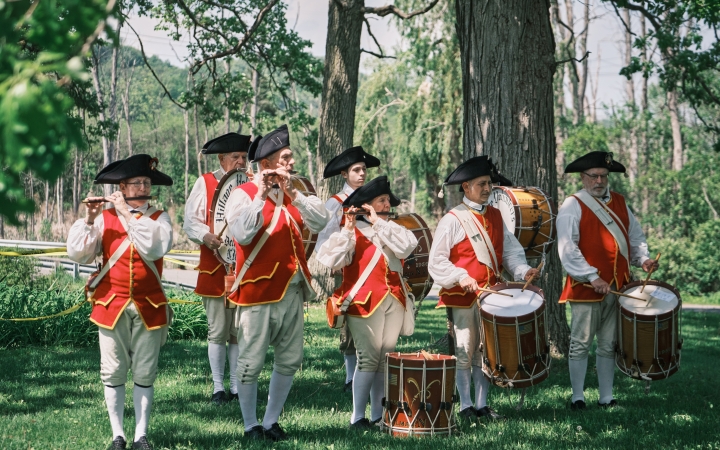
Pratt Rock
“New York’s Mount Rushmore”

Named for Revolutionary hero Nathanael Greene, Greene County is rich with the spirit of 1776. Celebrate the 250th anniversary of the Declaration of Independence and explore the stories that shaped America—right here in the Great Northern Catskills.
Revolution 250 + Other Historic Attractions
An Early Stand for Independence
In May 1775 — just a month after the first shots of the American Revolution were fired at Lexington and Concord — 225 local men from Coxsackie, NY, came together to take a stand. They signed the Coxsackie Articles of Association at the site that’s now the Bronck Museum, voicing their frustration over British taxes and the growing unrest in the colonies. Their bold declaration echoed the feelings of people across all 13 colonies and marked an early step toward the fight for independence.
In September 1797, New York Magazine described the mountains beyond Catskill as “furnishing many things for the gratification of the curious.” The audience they were speaking to were the movers and shakers of New York City – the fastest-growing city in the United States. Once a privilege of New York City’s ultra-wealthy, retreats to the countryside during the summer months were becoming more accessible to a new middle class.
The Catskills offered an escape unlike any they had seen before–cascading waterfalls, shaded glens, and sublime vistas that stirred the imagination and amazed visitors. Kaaterskill Falls, one of the tallest waterfalls in New York State, continues to captivate with its dramatic two-tiered drop and sweeping views that once inspired Hudson River School of Art painters and now inspire adventurers and photographers alike. Yet for those seeking something more secluded, the region is also home to countless hidden gem waterfalls tucked away in quiet forests and lesser-known trails.
But it was 1824 that truly marked a turning point. The Catskill Mountain House opened its doors as one of the first grand mountain resorts in the country, welcoming visitors eager to escape the city and enjoy the fresh mountain air. A year later, a young artist named Thomas Cole visited the area and began sketching the dramatic scenery. His paintings—and the breathtaking views from the hotel—quickly put the Catskills on the map. The Catskill Mountain House attracted and inspired a community of painters and writers, including author James Fenimore Cooper, a pioneer of the American novel.
For a century after, the natural landscape of the Catskill Mountains was celebrated, visited, and partially preserved by private citizens. These efforts ultimately led to the creation of the Catskill Park, forever preserving the places that first inspired some of America’s earliest visionaries. The Catskill Park was a revolution in public access - forever guaranteeing the public a chance to experience America’s first wilderness.
Discover the Oldest Surviving Home in Upstate New York
Built in 1663 by Dutch settler Pieter Bronck, this historic farmstead—now the Bronck Museum in Coxsackie—is one of the Hudson Valley’s most remarkable historic sites. Its preserved stone and brick buildings, along with a rare 13-sided barn, offer a window into early Colonial life. Walk the same grounds where 225 patriots signed the Coxsackie Declaration in 1775, and explore a collection of centuries-old barns and homes that reflect the region’s Dutch heritage and Revolutionary spirit. From its architecture to its role in America’s founding story, the Bronck Museum brings the past vividly to life in an unforgettable setting.
Open seasonally from May through October. Plan your visit and experience history where it happened.